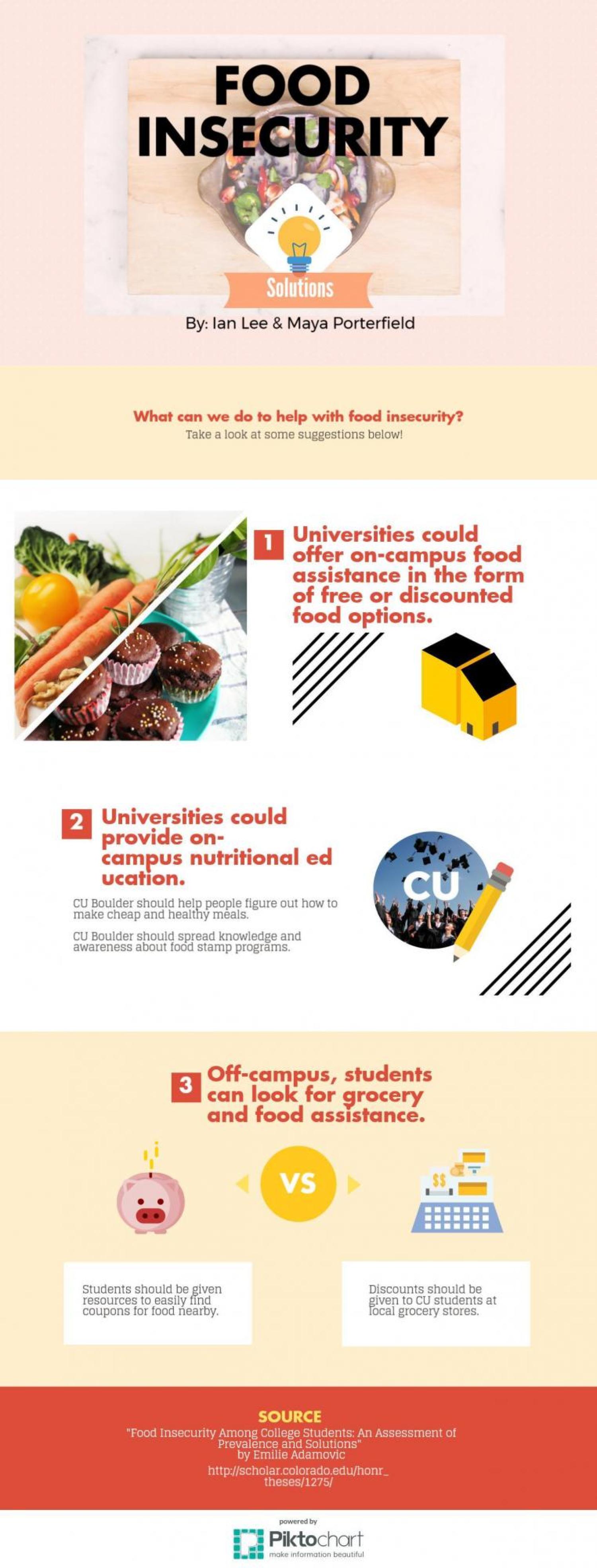Foodie Buffs
Poor Nutrition Can Undermine an Education
By Sydney Engel
Students struggle to pay for rent, tuition, and textbooks. Sometimes food can be the last thing they buy. The quality of and access to nutritious foods may ultimately determine whether the student earns an A or fails a class. The inability to afford and even access nutritious foods leads to food insecurity – a problem that impacts 1 in 8 Americans.
The USDA estimated that the demand for food will rise by 70 to 100 percent by 2050 due to population growth.
According to the Center for Disease Control, Americans aren’t eating enough, not by choice, but because they can’t afford to. A college education costs on average of $60,000 for out-of-state students. For many of them, that doesn’t leave much left over for food. When students can’t afford a nutritious meal every day, it adds to the stress they already have from trying to keep up with homework and other responsibilities. This kind of stress can impact their ability to function as a student.

Infographic by Ian Lee and Maya Porterfield
Lack of food leads to poor performance
Term papers, tests, reading assignments and projects under deadline pressure are some characteristics of the typical student workload. For others, that’s not enough. There’s the intensity of athletic training, Greek life, holding a job, doing an internship and numerous other extracurricular distractions. With all these opportunities come more expenses.
University of Colorado Boulder nutritionist, Jane Reagan, explains the more stress we put on ourselves, the more our bodies consume B vitamins, which can’t be replenished if the student isn’t eating consistently, leading to lack of focus and lethargy.
Food is directly correlated to our ability to retain information. People who eat food high in sugar experience the sensation of “crashing” within hours. Unfortunately, many students will often only have time to eat a candy bar or other snacks that later will leave them feeling drained, depressed or lethargic. The lack of food contributes to brain fog, and ultimately grades will suffer.
“If someone is not eating proteins regularly or is really deficient in calories too, people can feel really fatigued and they can get nutrition deficiencies. They can get iron deficiency, they can get B12 deficiency, if people don’t eat enough vitamin D-rich foods or aren’t out in the sun, they can also have compromised immune systems. They are also more prone to depression,” said Reagan.
When food has such a powerful influence on the way a body operates daily, it is essential to fuel yourself with positive nutrients.
CU Boulder Helping Student’s Health
The University of Colorado Boulder tries to support every student’s diet from all spectrums, while still providing the given foods. In dining halls around campus (C4C, Sewall, UMC) there are signs to remember the portion size of each food you pick in order to avoid food waste.
Wardenburg health services offers free nutrition consultations with a registered dietitian. After this students can make appointments for $120 for an hour of consulting. The dietitian will make recommendations for health concerns the student might have (a sports diet, anorexia, weight gain, diabetes). A student can also receive medical referrals if necessary.
The Nutrition Resource Clinic has provided many students with healthy and practical diets or guides to follow throughout the school year. It is recommended students access this, as many are unaware of the basic nutrition facts, such as food groups and other vital knowledge in understanding how food can affect your body and state of mind.
CU Boulder has hosted many speakers ranging from the Leeds Business School to the School of Natural Resources and Environment to speak on the topic of nutrition and food insecurity. Both professors and students have shared their research through studies as well as held conferences and seminars.
In April 2017, the seventh annual Conscious Capitalism Conference on Food Security was held by the Center of Education on Social Responsibility (CESR) with Keynote Speaker Kimbal Musk.
Many professors and chairmen discussed how to design a flourishing food system for an uncertain future. The Faculty Panel for Sustainable Food Systems explored producing and distributing the correct healthy measures for the current generation.
Leeds Professor Randy Johnston led the Accounting Ethics Senior Seminar in which many discussions about college food was brought up. This seminar ranged from topics about food deserts, factory farming, animal agriculture and more.On the CESR blog, Johnston said “[t]he bigger issues are your daily food choices: what you’re choosing and what the consequences of your food choices are.”
The CU Environmental Studies Program conducted a survey with current Boulder students on the prevalence of food insecurities on campus. CU senior Emilie Adamovic conducted a survey on food insecurity among CU students. She hopes the survey results could change the way the Boulder campus and community can help student in need access food.
The Volunteer Resource Center also provides information about food justice. The university is aware not everyone has equal or fair access to food, which is why they provide service to those in need of help.
For example, the Volunteer Center provides Give-A-Days in which once a month they hope to positively affect the Boulder community. The most recent food related Give-A-Day was in February where there was a Community Food Share.
VRC Assistant Director Alyssa Willet said that the campus doesn’t have its own food pantry, however, students can access them off-campus.
“Community Food Share said we have food, we have emergency food boxes,” said Willet. “So currently for any student on campus if they needed food, it is a non perishable box that proves two to three days worth of food.”
Gardens Growing Intelligence
By Christina Robben
Imagine a child not knowing that french fries come from potatoes, or looking at a carrot and not knowing what it is. Unbelievably, there are children and even adults that simply don’t know what their food is or where it comes from.
Fresh produce is oftentimes expensive and can be hard to access. In response, a non-profit organization in Boulder, Colorado, called The Kitchen Community set out to educate children using a tool called the learning garden. This structure distributed to low-income schools increases students understanding and willingness to consume fruits and vegetables. These engaging gardens help to hold students interest by achievement, knowledge and team building opportunities.
Infographic by Maya Porterfield
Their team relies on family foundations, private donors, grants and politicians for support to build outdoor classrooms. They believe connecting students with the community is vital. Learning gardens have even been proven to increase test scores and decrease the likeliness of receiving diabetes. Even the Huffington Post says that “[h]ands-on experience of growing their own foods have been shown to make children more eager to taste new foods.”
Courtney Walsh, the director of communications at The Kitchen, talked about how their regional teams set up the structures where the students carry bags of organic soil into the permanent infrastructure. They take place in the middle of the school yard and each is unique. The children then plant whatever they want in the edible gardens. Walsh said that “the kids can take the food home to their families or if they want to make a salad at school they can as well. They can bring home kale when many times their parents have never heard of kale.” With families that are so underexposed to natural foods, the gardens are an imperative key to educating our youth on proper nutrition.
Targeting schools in cities with low-income rates helps in various ways. Walsh continued on the subject, stating that “many students are disconnected from where their food comes from. Learning gardens help students understand they can actually grow fruits and vegetables which helps with food security.”
Working together not only helps children understand relationships, but how to eat and enjoy nutritious food. Students are thrilled and interested to see what can be produced from their efforts in the gardens. Increasing their desire to consume and grow healthy foods can prevail more sustainable eating habits in the future.
These gardens are different at every school and stand at 19 inches tall making them the perfect height for children. The gardens are made for students in kindergarten all the way through 8th grade. Each garden is customizable to the location and age group.
There are more than 400 learning gardens in six cities affecting over 200,000 students. Walsh explains that “knowing we are helping at scale and meeting the kids is really inspiring. At the end of the day it’s truly about getting them in front of real food."




